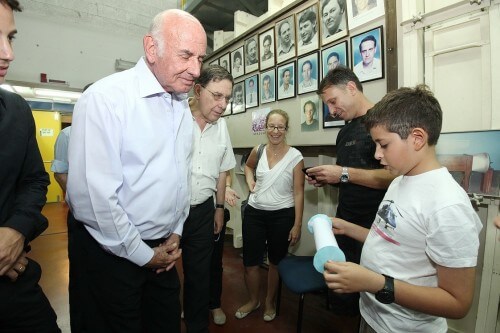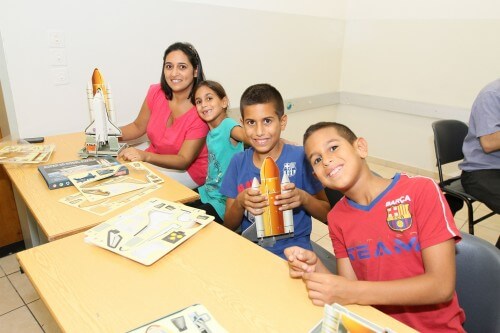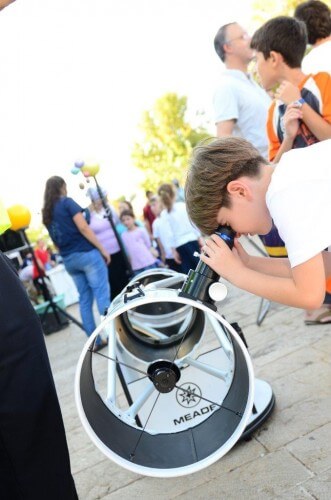Tens of thousands participated in the 2013 Scientists' Night events that took place this evening at 15 research institutions throughout the country in cooperation with the Ministry of Science, Technology and Space and the European Union

As part of the "Scientists' Night" events that took place tonight in collaboration with the Ministry of Science, Technology and Space and the European Union, about 40,000 people arrived today at the 15 event centers across the country - from Kiryat Shmona to Eilat. As part of the events, there was a special broadcast with the head of NASA, Charles Bolden, in which he said that NASA intends to launch people into deep space and land them on Mars and an asteroid, something that was not possible until now.
Bolden said that "NASA has recently made significant progress in its efforts to build a launcher capable of carrying a heavy payload that can take astronauts to greater depths in space. The tests conducted by NASA revealed that it is possible to achieve the goals of launching such a space vehicle. The same launcher will be able to carry astronauts to new distances and land them on asteroids and Mars, which has not been possible for humans so far. This space vehicle will be called "Orion" and will have the possibility of carrying astronauts into deep space. Next year, NASA will conduct the first vehicle test."
During the events, the research institutions and science museums across the country opened their doors to the general public free of charge and offered a variety of space-themed activities such as: face-to-face meetings with scientists, laboratory tours, lectures, experiential workshops, performances and demonstrations. The Ministry of Science, Technology and Space designated 2013 as the Year of Space to mark the tenth anniversary of the space shuttle "Columbia" disaster, on which the first Israeli astronaut, the late Ilan Ramon, was also aboard.
The Minister of Science, Technology and Space Ya'akov Perry said today as part of the events at Tel Aviv University, "Science is part of the Israeli being. The tens of thousands of people who came today to the Night of Scientists events prove that the power of the Jewish mind, which continues to invent, research and develop abilities for the benefit of all humanity, is not a miracle. The space field is developing by leaps and bounds, it is Israel's future industry that already places it among the eight leading countries in the field in the world. I have no doubt that this field will occupy many of the children who came tonight in the near future."
Thousands of participants in "Scientists' Night" 2013 at the University of Haifa

Thousands of children, teenagers and adults came to the Night of Scientists events that took place today (Thursday) at the University of Haifa and participated in the activities, lectures and workshops in an evening dedicated entirely to the subject of space. "This is further evidence of the Israeli public's thirst for knowledge and we are happy to share our knowledge with you here at the University of Haifa," said university president Amos Shapira at the main event, where an interview with the head of NASA was screened.
One of the main attractions of the evening, in which hundreds of teenagers participated, was the "Space Race" - a prize-bearing competition that included a series of space-related tasks and challenges that the contestants had to overcome. The workshops, which included, among other things, building a model of the Columbia ferry and a creative writing workshop, were full to capacity. The participants also enjoyed watching the stars in a reconstructed model of the telescopes of Albert Einstein and Galileo Galilei, launching water rockets and, of course, lectures on space by the best researchers of the university.
Scientists' Night 2013 at Tel Aviv University: models of Israeli spacecraft and launchers
Thousands of children, teenagers and families participated tonight in the Night of Scientists events at Tel Aviv University.
In the center of the campus were placed life-size models of an optical satellite, an Arrow 3 missile, an unmanned aircraft (ML), a satellite launcher, a SpaceIL spacecraft that will be launched to the moon, telescope positions were placed for guided stargazing, and a planetarium was even established. At the colorful event, there were tours of the laboratories, lectures on groundbreaking research and scientific experiments were demonstrated at eye level. The Minister of Science, Space and Technology, Yaakov Perry, opened the Scientists' Night events at the university and was impressed by the laboratories and experiments.
President Bar Ilan: To pass on to the next generation the thirst and the desire to explore
The Minister of Science, Mr. Jacob Perry, also arrived this evening (Thursday) for the night of the scientists at Bar-Ilan University and met with Prof. Koa, the president of the university. The event was attended by about 8000 children who came to the science fair accompanied by their parents.
The minister was impressed by the scientific activity complex at the lecturers' fair and the students presented him with demonstrations of a science experiment, the minister also got to see an impressive medieval warfare show and the highlight was the display of the most advanced robots made on campus which won first place in world competitions.
Prof. Moshe Kove, the president of the university, stated, "This is one of the events and the most important lesson in the intergenerational transition in the world of science and wisdom is to pass on to the next generation the thirst and the desire to explore and there is nothing more important than that for the world of science and the economy of Israel." Prof. Koa added "Science connects many parameters such as time and place. There are children here from all over the country and the great beauty is that doctoral students in the field of exact sciences pass on knowledge to the younger generation, and in 10 years the little children may become the next generation of tomorrow's scientists."
Physics and Space Engineering - at the center of the Scientists' Night at the Technion

About 4,000 visitors participated tonight in the "Scientists' Night" that took place at the Technion and dealt with the fields of space and astronomy. The event, which took place under the auspices of the Ministry of Science and Technology and the European Union, included diverse scientific exhibits and activities for the whole family, lectures on groundbreaking research, demonstrations and open experiments, laboratory tours and more.
The event was led by the Faculty of Physics and the Faculty of Aeronautics and Space Engineering at the Technion. Among the activities that took place: a rocket launch, a display of aviators and tiny planes, viewing telescopes, and lectures on the "divine particle" and "strange planets outside the solar system".
The Faculty of Aeronautics and Space Engineering at the Technion is the only faculty in Israel that trains engineers in these fields; And in the Faculty of Physics at the Technion, 38 scientists - professors and graduate students - are engaged in research in the field of astronomy.
During the event, open lectures were held by the Russian cosmonaut Yuri Shergin, the American astronaut Jim Newman from NASA, who spent 43 days in space on four different flights, and the renowned astrophysicist Professor Mario Livio, a researcher at the Hubble Space Telescope Scientific Institute.
A thousand visitors to the Open University
The writer of these lines specifically chose the campus of the Open University in Ra'anana, which included interesting lectures on mass extermination; The connection between music and astronomy as well as lectures that dealt with the question of future contact with aliens if and when they land. According to Prof. Yoav Yair, a member of the Faculty of Natural and Life Sciences at the Open University, says that during the day (which also included the research day) and at night, the scientists visited the Open University campus about a thousand people, including many teenagers and entire families.
And these are just a few of the institutions where events open to the general public were held.

6 תגובות
Uncle
Maybe you'll wake up. From everything I've read from your words, it is evident that your knowledge of astronomy is extremely limited, to say the least. Please do your astronomy homework carefully for the analysis you are writing. If you were a student with me you would have failed.
Uncle
Are you really that stupid?
I don't see it happening anytime soon, NASA's budget is being cut every year and that's how you can't move forward.
There is simply no commitment like there was with the moon landing, I don't think it will happen in the next 20-30 years, I hope I'm wrong.
Neither Mars nor shoes, maybe they will reach the moon because the technology belongs to that era, not to mention Mars, a small capsule
where a few people crowd, it is good for a few days but not for a journey of more than six months,
I really have no idea what they're talking about there these days.
The problem is not them, it is the state that maintains them
The will and the resources that are ready to be invested, and in the economic situation of the USA this probably won't happen in the medium term,
The big investment should be in a spacecraft that protects against radiation and creates gravity probably by centrifugal force,
Otherwise the astronauts could die on the journey there in one of the sun's eruptions
Regardless of the continued damage of the radiation that is outside the magnetic shielding of the Earth,
And besides, we all know what an astronaut looks like after a few months in space who returns to Earth, more like someone who needs to go into a geriatric institution than one who takes even a small step for man and a giant step for humanity, they can't walk, so the first thing they'll do when they land on Mars
will fall on their face without Russians waiting for them with an armchair and a pillow against the cold and a slice of black bread,
So the next sentence will probably be a little creepy for a person and…. And it's not certain that there will be a sequel,
Not to mention that the International Space Station constantly receives supplies from Earth every few months,
So where will they have food, this is a huge task with logistics of food, water and air at levels we have not yet known,
Just the flight there takes about 7 months and then you have to wait
On Mars for months and then a flight of months back, this is approaching a 3 year journey,
In short, there is a lot of work that needs to be done and it is not really done now, it is a long and possible process
If there are the struggles of a power behind it with the technologies that exist today and are willing to take risks,
Since you don't see any real massive plan that answers the many problems the realistic range is likely
It is more than 30 years and maybe it will be the Chinese who were the first,
What's more, if they want to build a manned station on the moon, it is much more possible and suitable for the economic situation
And the technology exists, but it's not a small thing either, it should be more expensive than the international station
Farther, more complicated landing, etc...
Not deep space, not Mars, not even the moon, there is no such possibility in today's technology, because of the Van Allen radiation belt, so it's a shame that you just talk to children about flights beyond 600 km from the earth, and the trick of landing on the moon